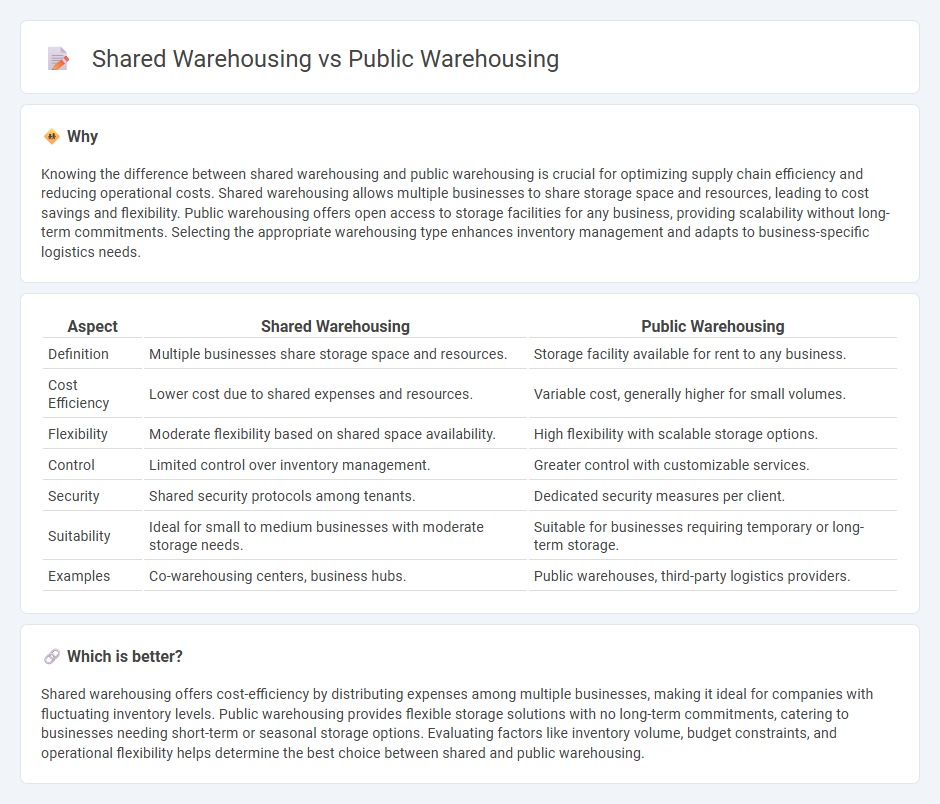
Shared warehousing offers cost-effective space utilization and flexible storage options by allowing multiple businesses to use a single facility, enhancing operational efficiency. Public warehousing provides accessible, short-term storage solutions without long-term commitments, ideal for fluctuating inventory demands and businesses seeking scalable logistics support. Explore the distinct advantages and applications of shared versus public warehousing to optimize your supply chain strategy.
Why it is important
Knowing the difference between shared warehousing and public warehousing is crucial for optimizing supply chain efficiency and reducing operational costs. Shared warehousing allows multiple businesses to share storage space and resources, leading to cost savings and flexibility. Public warehousing offers open access to storage facilities for any business, providing scalability without long-term commitments. Selecting the appropriate warehousing type enhances inventory management and adapts to business-specific logistics needs.
Comparison Table
| Aspect | Shared Warehousing | Public Warehousing |
|---|---|---|
| Definition | Multiple businesses share storage space and resources. | Storage facility available for rent to any business. |
| Cost Efficiency | Lower cost due to shared expenses and resources. | Variable cost, generally higher for small volumes. |
| Flexibility | Moderate flexibility based on shared space availability. | High flexibility with scalable storage options. |
| Control | Limited control over inventory management. | Greater control with customizable services. |
| Security | Shared security protocols among tenants. | Dedicated security measures per client. |
| Suitability | Ideal for small to medium businesses with moderate storage needs. | Suitable for businesses requiring temporary or long-term storage. |
| Examples | Co-warehousing centers, business hubs. | Public warehouses, third-party logistics providers. |
Which is better?
Shared warehousing offers cost-efficiency by distributing expenses among multiple businesses, making it ideal for companies with fluctuating inventory levels. Public warehousing provides flexible storage solutions with no long-term commitments, catering to businesses needing short-term or seasonal storage options. Evaluating factors like inventory volume, budget constraints, and operational flexibility helps determine the best choice between shared and public warehousing.
Connection
Shared warehousing and public warehousing are interconnected by offering flexible storage solutions that optimize space utilization and reduce operational costs for multiple businesses. Both models enable companies to access scalable inventory management without long-term commitments or the need to invest in private facilities. This collaboration enhances supply chain efficiency by facilitating consolidated shipments, faster order fulfillment, and improved inventory accuracy.
Key Terms
Ownership
Public warehousing offers storage facilities owned and operated by third-party providers, allowing businesses to rent space without upfront investment or long-term commitments. Shared warehousing involves multiple companies using a common facility, optimizing space and resources while maintaining separate inventory management under one roof. Explore the advantages and cost implications of public and shared warehousing ownership to determine the best fit for your supply chain needs.
Cost Structure
Public warehousing offers a pay-as-you-go cost structure with fees based on storage space and duration, making it ideal for businesses with fluctuating inventory levels. Shared warehousing reduces expenses by distributing fixed costs such as rent, utilities, and labor among multiple clients, promoting cost efficiency for consistent storage needs. Discover how each warehousing model can optimize your supply chain budget effectively.
Flexibility
Public warehousing offers high flexibility by allowing businesses to store goods on a short-term or long-term basis without committing to a fixed space, ideal for fluctuating inventory levels. Shared warehousing provides cost-effective flexibility by enabling multiple companies to share storage space and resources, optimizing operational efficiency and scalability. Explore in-depth comparisons to determine which warehousing solution best supports your business flexibility needs.
Source and External Links
What is Public Warehousing? - Axis Warehouse - Public warehousing is a cost-efficient storage solution provided by third-party providers where multiple businesses share a facility, paying only for the space and services they use, with flexible terms and added services like inventory management and order fulfillment.
Public Warehouse: Definition, Benefits, and Features - Public warehouses offer businesses access to storage and shipping facilities without large upfront investment, providing flexibility and reduced overhead but less control over inventory and potential risks of mix-ups in shared space.
What Is Public Warehousing? Benefits, Types & How It Works - Public warehouses are third-party, multi-client facilities ideal for businesses with varying inventory needs, offering flexible, scalable storage at lower upfront costs but with less operational control compared to private warehouses.
 dowidth.com
dowidth.com